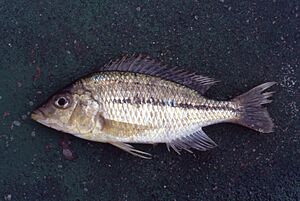Protomelas kirkii facts for kids
Quick facts for kids Protomelas kirkii |
|
|---|---|
 |
|
| Protomelas kirkii, female, freshly caught by beach seine in Monkey Bay, Lake Malawi in 1992 | |
| Conservation status | |
| Scientific classification | |
| Synonyms | |
|
The Protomelas kirkii is a type of cichlid fish. It lives only in Lake Malawi in Africa. You can often find it in areas with lots of water plants called Vallisneria. This fish can grow up to about 18 centimeters (7 inches) long. Sometimes, people also keep Protomelas kirkii as a pet in aquariums.
Contents
What Does Protomelas kirkii Look Like?
This cichlid fish has a body that is quite deep. It has a small mouth that faces forward. Its color is usually yellow-brown. You can see a clear dark stripe along its side.
Protomelas kirkii often lives near other similar-looking fish. These include Protomelas similis and P. labridens. You can tell Protomelas kirkii apart by its longer snout. It also has a small mouth at the very front of its head.
Colors of Males and Females
Female fish and young fish have special coloring. They are yellowish-brown on top. Their sides and belly are lighter. They have a strong dark stripe along their middle. Sometimes, there is another thinner dark band. This band is halfway between the main stripe and the dorsal fin (the fin on its back). You might also see dark spots near the base of the dorsal fin. Faint dark bars can sometimes appear on their sides. The tip of the dorsal fin has a red edge.
Adult males are usually much bigger than females. They are a bright, shiny blue-green color. Their dorsal and caudal (tail) fins have many orange-red spots. The anal fin (on the belly) is dark reddish. It has many yellow-white spots and streaks. Male fish also have reddish edges on many scales behind their head.
How Protomelas kirkii Got Its Name
This fish was first described in 1894. It was named Chromis kirkii by Albert Günther. He worked at the Natural History Museum in London. The fish specimens were sent to him by Sir Harry Johnston. He was a governor in Africa at that time.
The name kirkii was likely given to honor Sir John Kirk. He was an explorer who traveled with David Livingstone. Kirk had sent other animal samples to Günther before. Over time, this fish's name changed. It moved between different groups of fish. For a long time, it was in the group Haplochromis.
In 1989, scientists David Eccles and Ethelwynn Trewavas created a new group. They called it Protomelas. They made C. kirkii the main example for this new group. This group includes about 14 types of cichlid fish from Lake Malawi. These fish share similar dark markings on their bodies.
Where Protomelas kirkii Lives
Protomelas kirkii lives only in Lake Malawi and the rivers that flow into it. You can find it all over the lake where the habitat is right. It also swims into rivers. For example, it lives in the Shire River as far as the Kapachira Falls. It is also found in Lake Malombe.
Life and Reproduction
Protomelas kirkii prefers shallow, weedy parts of the lake. It also lives in nearby rivers. These fish eat small invertebrates. They find these tiny creatures on the lake bottom.
This species is a typical maternal mouthbrooder. This means the mother carries her eggs and young in her mouth. Male fish build a small mound of sand or dirt. They often clear away weeds in shallow water, less than 2 meters (6.5 feet) deep. The males protect their areas. They try to attract females to lay eggs with them.
Once the eggs are laid, the female collects them in her mouth. She keeps them safe there for a few weeks. After the young fish hatch and are strong enough, she releases them.
Protomelas kirkii and Humans
People catch Protomelas kirkii for food. They use large nets called beach seines in the shallow waters of the lake. In Malawi, this fish is often called 'Kambuzi'. This name is also used for other small fish caught in shallow water.
Sometimes, Protomelas kirkii is sold as a pet fish for aquariums. It is known to be strong and healthy in captivity. However, it needs alkaline water (pH 7–8.5). Male fish are known to be very territorial. This means you should usually only keep one male in a standard home aquarium.
Currently, the Protomelas kirkii is listed as 'least concern' by the IUCN Red List. This means it is not in danger of disappearing.
Images for kids





